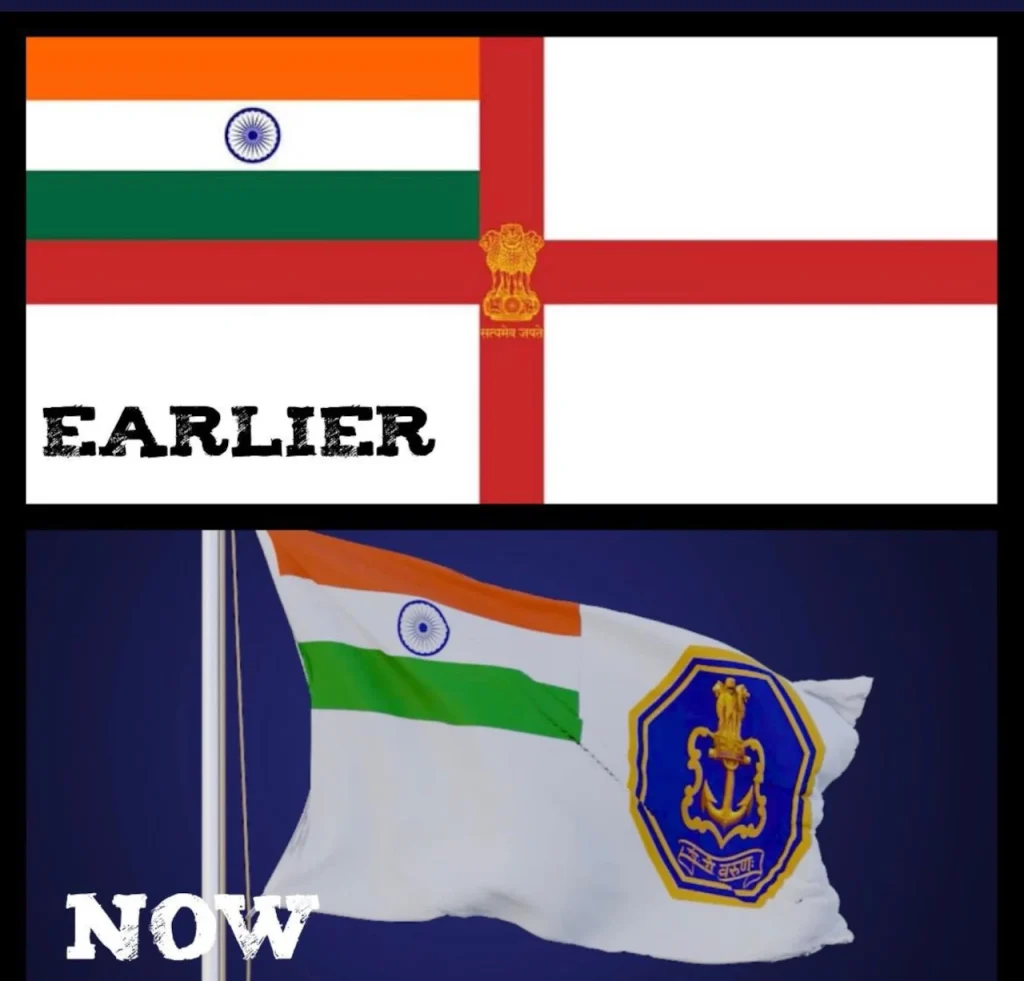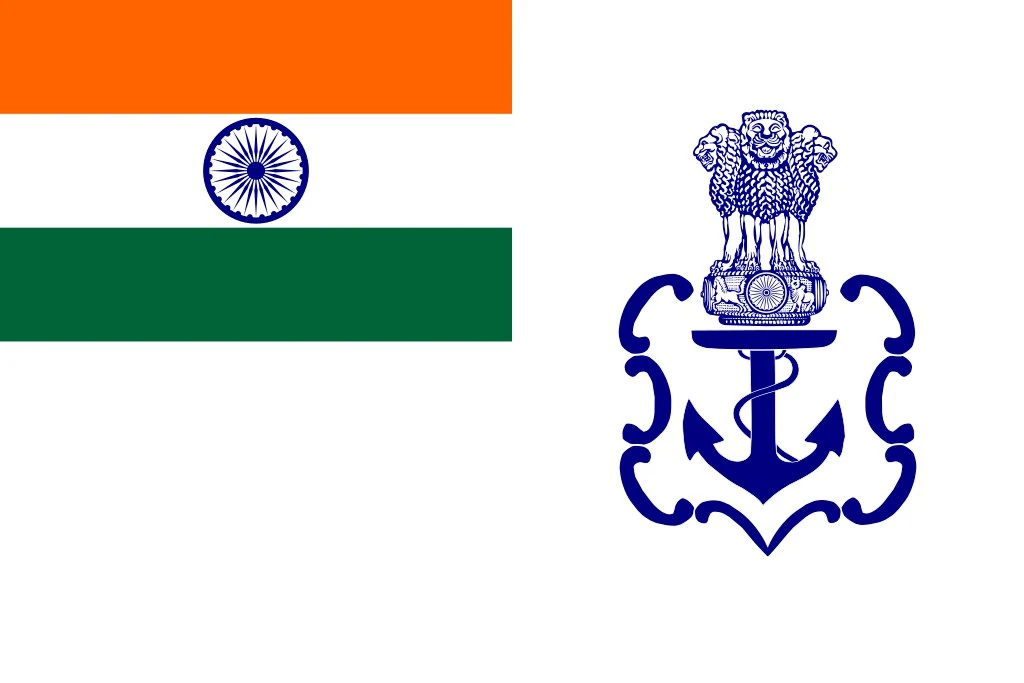The Indian Navy recently received a new Ensign, which will now adorn the Naval ships, vehicles, and buildings. There are mixed feelings among the sailors and officers about the change. For most, the new Ensign is simply not graceful as the old one, which may be seen in the colour clashes between the Indian Tri Colour and the Blue and Yellow on the Octogan. But aesthetics means different for different people, so it can be debated and argued to death. It can also mesh into the the current religion debate. For the general population, it is a matter of national pride rather than the aesthetics of Ensign.
Explaining the change of the Ensign, the Navy said that in keeping with the continuing national effort to break away from the colonial past, it was thought necessary to shift to a new design that took inspiration from Indian history.
The previous Indian Naval Ensign had the National Flag in the top left canton, red vertical and horizontal stripes, and a golden yellow State Emblem placed over the junction of the red stripes as a mark of national pride. The national slogan ‘Satyamev Jayate’ was carved in the Devanagari script underneath the State Emblem. This White Flag was flown by the Indian Navy’s formations, ships, and installations till September 1, 2022.
The red horizontal and vertical stripe is in reference to the St George’s Red Cross flag. Understanding the sentiments behind the wide adoption of the symbol that still captivates the world is important.
St George Red Cross – A personal and not religious or national symbol
Georges de Lydda was born into a Christian family in Cappadocia. He joined the Roman army as an officer, and Emperor Diocletian gave him the highest rank in the army.
One day, he rides his white horse through the city of Silenus in the Roman province of Libya. A scary dragon terrorises the city. It eats all the animals in the area and demands a tribute of two young people from the people who live there every day. George shows up on the day that the king’s daughter is doomed to be killed by the monster. George fights the dragon fiercely. With Christ’s help and after making the sign of the Cross, he stabs the dragon with his spear. The princess is brought to the city, and the dragon follows her like a good dog. The people of the city agreed to become Christians and get baptised. Because it always scared the people, George killed the dragon with a blow from his scimitar. In popular versions, George kills the dragon immediately after the battle with his spear. The story is considered a tradition and not a fact.
Georges is put in jail after Diocletian’s laws against Christians are made public. His faith could not be shaken, and he died a horrible death there as a martyr. He was sent to be tortured many times, but by some miracle, he survived. On April 23, 303, he was beheaded. Islamic accounts say that he was born over and over again, a feat that Jesus of Nazareth did.

Eastern Christians called him “the great martyr” because of the exceptional way he died. His group of followers grew quickly. Saint George’s cult became very popular during the Crusades, especially among French and English knights. The riders had every right to pick him as their patron saint. Their symbol is usually a white flag with a red cross on it.
One of his first appearances after death was at the Battle of Cerami in June 1063. This was after the Normans had started to free Sicily, which Muslims had ruled for 200 years. In this fight in the northeast of the island, the Christians won big. According to a historian named Geoffroi Malaterra, they were inspired by a mysterious white horseman with a spear, a white pennon, and a cross on its end.
During the siege of Antioch by the unbelievers in 1098, Christians saw a vision of St. George at the head of an army of angels riding white horses and carrying white banners. This gave the Christians victory.
At the Battle of Alcoraz in 1096, King Peter I of Aragon is said to have won against the Moors. He said Saint George helped them win against the four Arab kings killed on the battlefield.
Since 1297, when Pope Boniface VIII made Sardinia a subservient zone, it will use the symbols from this feat of arms: a white flag with a red cross and four Moorish heads.
In the 12th century, the House of the Counts of Barcelona took over Aragon. Raimond-Bérenger IV and his son Alphonse II put their coat of arms on each of the four pales. This last coat of arms would stay as the dynastic symbol of Aragon. The Red Cross would stay as the territorial symbol of the old kingdom.
The vexillum beati Georgii (Flag of Saint George) was first mentioned in the Chronicles of Genoa in 1198. It is a red flag with a picture of Saint George on horseback killing a dragon ( this standard would remain the state flag until the beginning of the 13th century). In the Annales Januenses, which tells the story of how the Genoese took over the city of Savona in 1227, there is a picture of a banner with four tails set up in front of the tents of the Genoese commanders. The Flag of the Community, which is a red cross on a white background, was first seen on September 28, 1218. It was called “the ensign with the cross of the Community of Genoa,” or “insignia cruxata comunis Janue,” and it flew over the city of Ventimiglia, which had given up to Genoa. The fleet also used these two flags. In 1241, the vexillum beati Georgii was still called the Flag of War and Ensign of the Admiral. In 1242, the galleys flew the signum Communis, which means the Flag at the Cross. At least until 1282, the vexillum beati Georgii would be the Admiral’s Flag.

People say that the Cross of Saint George was first used as a symbol by the English army in 1277 when Edward I was in charge, and there was a war in Wales. Archbishop Thomas of Canterbury wrote in the 1300s that King Edward of England’s knights carried white banners with red crosses when they besieged Caerlaverock Castle in southern Scotland in 1300. In 1357, a historian named Jean Froissard wrote that English commanders often call on Saint George for help or as a battle cry.
Georgia was the last country to use the Red Cross. Its name comes from the Persian word “Gurji,” which comes from the Greek word “gergia,” which means “agriculture”, and not from Georges de Lydda’s name.
The Flag that was chosen in 2004 has a white background with a red cross in the middle and four more red crosses around it. It is related to the Flag of Sastavo, which was first seen in 1350. The Democratic Movement of Mikheil Saakashvili, an opposition party that will be in power after the Rose Revolution, chose it as their symbol in 2001.
People also use the white Flag with the Red Cross to represent the Church in general. It is used by painters when they show the Resurrection or the Last Judgment.
The Navy had brought back St George’s Red Cross
In 2001 the Navy changed the Ensign, removing the St George’s Cross and putting a Naval emblem.
In 2004 the Red Cross in the Ensign was brought back because the Navy felt that the Ensign was not as conspicuous as it had been.
